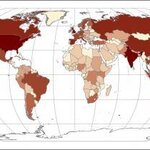Immunology

Ebola is causing a lot of concern, a few instances in the United States were enough to lead to calls to overthrow the FDA vaccine approval process and the White House declared that the United States Department of Health and Human Services was unqualified to manage a handful of cases in America so they put a lawyer in charge as an Ebola czar. The National Institutes of Health said they could not fix the problem with the $330 billion they have gotten since 2001 but they are just exploiting an outbreak for personal gain also. In reality, the impact of disease outbreaks has been declining on…

Flying by Shutterstock
By Stephen Goldstein, University of Pennsylvania
Fear of Ebola has put many on high alert and there is increasing anxiety about the possibility of individuals with minimal exposure and no symptoms introducing the virus into communities – people such as Craig Spencer, the doctor who contracted Ebola while working in Guinea who then went bowling and rode the subway in New York before exhibiting symptoms.
Fear has kept people away from school and work, despite reassurances from the World Health Organisation (WHO) and the American Centers for Disease Control and Prevention…

Not everyone who contracts the Ebola virus dies, the survival rate is actually around 30%, which means some kind of immunity to the disease is possible.
Experimental treatments and vaccines against Ebola exist but there was little interest from governments in streamlining the bureaucracy before the recent outbreak, so they have not undergone phase 2 trials - the U.S. Congress did add $90 million to the $29 billion budget of the National Institutes of Health after Director Francis Collins said money was the thing that had prevented a vaccine in the past.
Writing in Frontiers in…

Antibiotics are a part of nature, as is antibiotic resistance. A study on how a powerful antibiotic agent gets made in nature solved a decades-old mystery and opens up new avenues of research into thousands of similar molecules.
The team focused on a class of compounds that includes dozens with antibiotic properties. The most famous of these is nisin, a natural product in milk that can be synthesized in the lab and is added to foods as a preservative. Nisin has been used to combat food-borne pathogens since the late 1960s.
Researchers have long known the sequence of the nisin gene, and they…

Your second brain? Credit: hey__paul, CC BY
By Clio Korn, University of Oxford
One of medicine’s greatest innovations in the 20th century was the development of antibiotics. It transformed our ability to combat disease. But medicine in the 21st century is rethinking its relationship with bacteria and concluding that, far from being uniformly bad for us, many of these organisms are actually essential for our health.
Nowhere is this more apparent than in the human gut, where the microbiome – the collection of bacteria living in the gastrointestinal tract – plays a complex and critical role in…

A new paper finds that the same specialized immune cells that patrol the body and spot infections also trigger the expansion of the immune organs known as lymph nodes.
The immune system defends the body from infections but can also spot and destroy cancer cells and lymph nodes are at the heart of this response, but it was unclear how they expand during disease.
Researchers at Cancer Research UK's London Research Institute found that when a type of immune cell known as dendritic cells recognizes a threat, they make a molecule called CLEC-2 that tells the cells lining the lymph…

Why were so many middle-aged adults hit especially hard by the H1N1 influenza virus during the 2013-2014 influenza season?
Vaccines work by stimulating the immune system to produce antibody proteins against particles (called antigens) from an infectious agent, such as bacteria or a virus. The immune system saves the cells that produce effective antibodies, which then provide immunity against future attacks by the same or similar infectious agents. Seasonal influenza typically kills 36,000 Americans, alone, and nearly 500,000 individuals around the world each year.
Historically,…

Some people infected with pathogens spread their germs to others while remaining symptom-free - a new study may answer why.
When researchers in a new study gave oral antibiotics to mice infected with Salmonella typhimurium, a bacterial cause of food poisoning, a small minority — so called "superspreaders" that had been shedding high numbers of salmonella in their feces for weeks — remained healthy; they were unaffected by either the disease or the antibiotic. The rest of the mice got sicker instead of better and, oddly, started shedding like superspreaders.
The findings point to a reason for…

Human parainfluenza virus (hPIV) is highly infectious and the leading cause of upper and lower respiratory tract disease in young children, including Croup, which is responsible for thousands of hospitalizations in the developed world, and hundreds of thousands of deaths each year in developing countries.
Griffith University's Institute for Glycomics
Director Professor Mark von Itzstein said his Group's research findings published in Nature Communications today provide a new direction towards the discovery of anti-viral drugs against hPIV.
"hPIV gains entry to human respiratory epithelial…

Fears of cholera coming shared a lot in common with fear of Ebola. Graetz 1883 © Historical Society of Pennsylvania
By Sally Sheard, University of Liverpool
On October 19 an inspector sent north from London to Sunderland reported a long-awaited arrival: the first British case of cholera.
It was 1831 and as part of a second pandemic cholera had again progressed from its Bengal heartland through Europe, before reaching the Baltic ports. It was only a matter of time.
Broadsheet warning in 1831. Wellcome Library, London, CC BY-NC-SA
The British public, informed by newspaper reports, were…